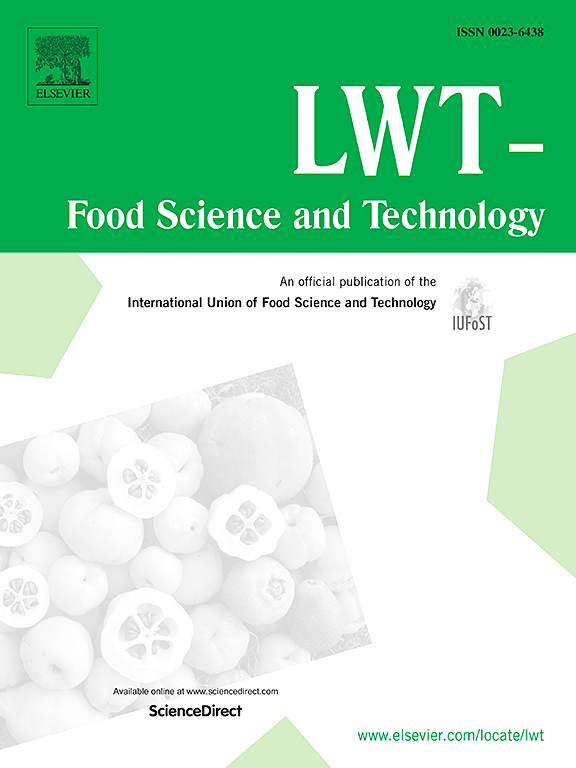Impact of tyrosine substitution on tachyplesin I: Development and characterization of the antimicrobial peptide TP I-Y4
IF 6
1区 农林科学
Q1 FOOD SCIENCE & TECHNOLOGY
引用次数: 0
Abstract
This study aimed to design a novel antimicrobial peptide, TP I-Y4, through the substitution of four cysteines with tyrosines in tachyplesin I (TP I), and to investigate its structure-activity relationship. TP I-Y4 exhibited reduced hydrophobicity and higher β-sheet content than the parent peptide TP I, both in aqueous environments and 50% trifluoroethanol (TFE). TP Ⅰ-Y4 demonstrated a potent, dose-dependent affinity for anionic lipopolysaccharide (LPS), and showed enhanced antimicrobial activities against a broad spectrum of bacteria and fungi with minimal toxicity. Structural modifications in TP I-Y4 increased adsorption to bacterial cell surfaces, resulting in significant reductions in surface electronegativity and increases in surface hydrophobicity than TP Ⅰ. These changes are hypothesized to enable TP Ⅰ-Y4 to inflict more damage to bacterial membranes, as well as liposome membranes, during peptide integration into the phospholipid bilayer. Fluorescence spectroscopy confirmed that both peptides were capable of integrating into the phospholipid bilayer, however, TP Ⅰ-Y4 displayed stronger binding and insertion abilities. These findings indicated that neither disulfide linkage nor Cys is essential for antimicrobial functionality. The reduced hydrophobicity, higher β-sheet content, and more flexibility are proposed as key factors contributing to the superior antimicrobial activity and substantially reduced cytotoxicity of the peptide derivative.
酪氨酸置换对流速蛋白酶 I 的影响:抗菌肽 TP I-Y4 的开发与表征
本研究的目的是通过用酪氨酸取代快速球蛋白 I(TP I)中的四个半胱氨酸,设计出一种新型抗菌肽 TP I-Y4,并研究其结构与活性的关系。与母肽 TP I 相比,TP I-Y4 在水环境和 50% 三氟乙醇(TFE)中的疏水性降低,β-片层含量增加。TP Ⅰ-Y4对阴离子脂多糖(LPS)具有强效、剂量依赖性亲和力,对广谱细菌和真菌的抗菌活性增强,毒性极低。与 TP Ⅰ 相比,TP Ⅰ-Y4 的结构修饰增加了对细菌细胞表面的吸附,从而显著降低了表面电负性,增加了表面疏水性。据推测,这些变化使 TP Ⅰ-Y4 能够在肽与磷脂双分子层结合的过程中对细菌膜和脂质体膜造成更大的破坏。荧光光谱证实,两种肽都能整合到磷脂双分子层中,但 TP Ⅰ-Y4 的结合和插入能力更强。这些发现表明,二硫键和 Cys 对抗菌功能都不是必需的。疏水性降低、β-片含量增加和灵活性提高是该肽衍生物具有更强抗菌活性和更低细胞毒性的关键因素。
本文章由计算机程序翻译,如有差异,请以英文原文为准。
求助全文
约1分钟内获得全文
求助全文
来源期刊

LWT - Food Science and Technology
工程技术-食品科技
CiteScore
11.80
自引率
6.70%
发文量
1724
审稿时长
65 days
期刊介绍:
LWT - Food Science and Technology is an international journal that publishes innovative papers in the fields of food chemistry, biochemistry, microbiology, technology and nutrition. The work described should be innovative either in the approach or in the methods used. The significance of the results either for the science community or for the food industry must also be specified. Contributions written in English are welcomed in the form of review articles, short reviews, research papers, and research notes. Papers featuring animal trials and cell cultures are outside the scope of the journal and will not be considered for publication.
 求助内容:
求助内容: 应助结果提醒方式:
应助结果提醒方式:


